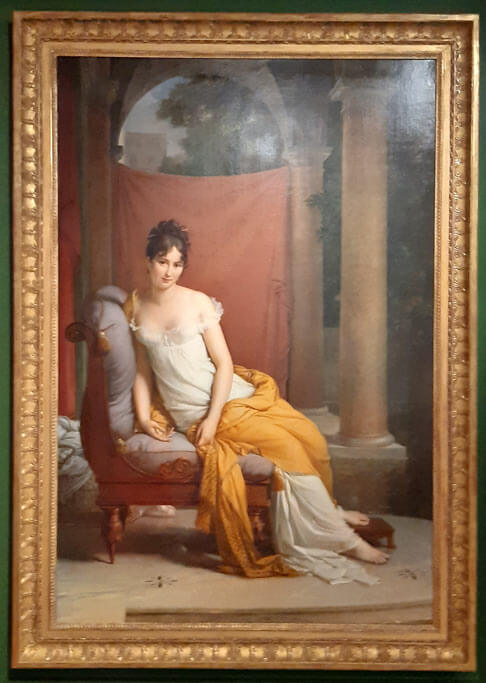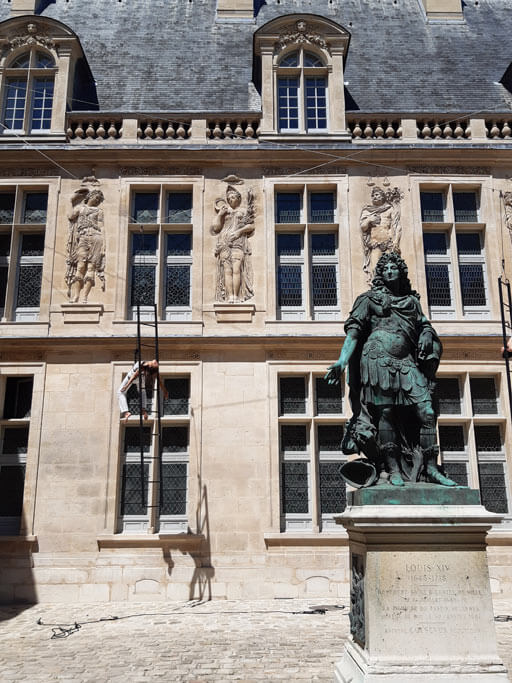The Musée Carnavalet (or Carnavalet Museum in English) is one of the best museums in Paris. This beautiful museum located in the Marais (Paris 3) is the oldest in the city, and we have it listed as one of the best things to do in Paris.
This museum is dedicated to the History of Paris from Prehistory to our days. Musée Carnavalet is one of the museums managed by the City of Paris, which means that it is free to visit for everyone.
After four years of renovation work, the Musée Carnavalet finally re-opened its doors in May 2021. I was lucky to find tickets to visit the museum on the first day and on the first time slot, so in addition to the exhibition rooms, I could enjoy some dance and music performances to celebrate the reopening. If you consider a visit to the Musée Carnavalet during your next trip to Paris, this Carnavalet Museum review will tell you everything you must know before booking your tickets.
READ MORE: here’s the list of best free museums in Paris

Carnavalet Museum’s Location

You will find the Musée Carnavalet in Le Marais, in the third disrict of Paris. Le Marais is one of the historic neighborhoods of Paris, located on the Seine’s right bank. This beautiful area is home to some interesting tourist attractions like Place des Vosges, Picasso Museum, or the Pletzl.
The museum occupies two private mansions (Carnavalet and Le Peletier de Saint Fergeau) built between the 16th and 17th centuries, which are among the most beautiful in Le Marais. The two mansions are connected by a long gallery, and they have private gardens and courtyards that visitors can also explore. Don’t miss Hotel Carnavalet’s Cour Henri IV or the stunning Cour des Drapiers.
What to See at Musée Carnavalet
Permanent Collections
The permanent collections at Carnavalet Museum consist of objects, furniture, paintings, maps, and models spread through four floors. They cover the history of Paris from Prehistory until today.
This museum also allows visitors to (re)discover the major Parisian figures and their personal objects. For example, you can see a reproduction of one of the rooms in the Tour du Temple, where King Louis XVI and his family spent their last days, as well as some objects that belonged to Marie-Antoinette. There’s also the bed on which Marcel Proust wrote most of his famous novel In Search of Lost Time.


Visitors entering the courtyard of the Hotel Carnavalet are greeted by a large standing statue of King Louis XIV, dressed as a Roman emperor. This recalls the King’s will to convert Paris into a new Rome. After some introductory rooms, the collections are divided into different sections:
- Prehistory, Antiquity and Middle Ages
- Paris from 1547 to 18th century
- French Revolution to the first half of 19th century
- From the second half of the 19th century to our days
I found especially interesting the new spaces in the basement, with the collections dedicated to the period going from Prehistory to Middle Ages. The rooms dedicated to Lutetia – Roman Paris are excellent!
Musée Carnavalet is also known as the ‘museum of the French Revolution’ because of its important section dedicated to the French Revolution. These rooms are also among my favorites. Also, I was impressed by the (original) mascarons of the Pont Neuf in Paris: they are huge, and each one weighs several tons!
Introductory texts are usually displayed in French, English, and Spanish, while most object descriptions are displayed in French and English.


In this new Musée Carnavalet, 10% of the works are exhibited at child height, with adapted texts. In addition, the museum’s free app also offers children the opportunity to discover and decipher nearly 130 works.
The Carnavalet Museum is huge! I spent three hours on-site and I could not see everything. My suggestion is to have a look at the map given of the museum and decide what sections interest you most.
Temporary Collections
The Musée de Carnavalet also organizes temporary exhibitions about life or history in Paris. These exhibitions have an admission fee, and you can buy the tickets on the museum’s website.
Architecture
The Musée de Carnavalet occupies two of the most beautiful private mansions (hotel particuliers) in the Marais: Hotel Carnavalet and Hotel Le Peletier de Saint-Fargeau. When visiting the exhibitions, it may be difficult to pay attention to the architecture of the site, but it is possible to access the hotels’ gardens and courtyards from where you can admire the beautiful interior façades and other details.
Hotel Carnavalet is one of the oldest private mansions in Paris. Built in the 16th century, it is one of the rare examples of Renaissance architecture in Paris. The hotel’s square plan, between the garden and courtyard, was an architectural novelty at that time which was later used for many other hotels in the area.


The access to the museum is through Hotel Carnavalet’s Cour d’Honneur, dominated by the statue of King Louis XIV. Don’t miss the bas-reliefs decorating the courtyard façades. Other interesting places to see in this beautiful hotel particulier are the Cour Henri, with the monumental sculpture of King Henri IV on horseback, the Cour des Drapiers and the monumental staircase with paintings en trompe-l’oeil by Brunetti.


Hotel Le Peletier de Saint-Fargeau was built in the 17th century in a much sober style. The hotel’s most beautiful architectural elements are the grand staircase, including the sumptuous cast iron support rail – molded and chiseled -, and the Orangerie, today dedicated to cultural events.

Should you Visit the Musée Carnavalet during your Trip to Paris?
If this is your first trip to Paris, the Musée Carnavalet is an excellent introduction to the city and its history. You can plan a day in the Marais, to visit the Musée Carnavalet and other beautiful sights in the area.
If you visited the museum during one of your previous Paris trips, consider a quick visit to explore the new underground rooms and the sections that interest you most. If your schedule in Paris is tight, I would suggest visiting places you haven’t seen yet or enjoying local life in the streets of Paris.
Musée Carnavalet – Info & Tips

Address: 23, rue de Sévigné, Paris 3. Closest metro stations are Saint-Paul, line 1, and Chemin Vert, line 8.
Opening Hours: Tuesday to Sundays, from 10 am to 6 pm. Last entry is at 5.15 pm.
Admission: the permanent collections are free to visit, but visitors must book a date and time slot online in advnce through the museum’s website. Use the same site to buy tickets for the temporary collections and other events.
What to Do Near the Carnavalet Museum?
- Picasso Museum
- Place des Vosges
- The Pletzl
- Maison de Victor Hugo
- Musée Cognacq-Jay
- Restaurants in Paris 3
- Ile Saint-Louis
- Batobus Paris (Seine Hop-on Hop-Off Cruise)

